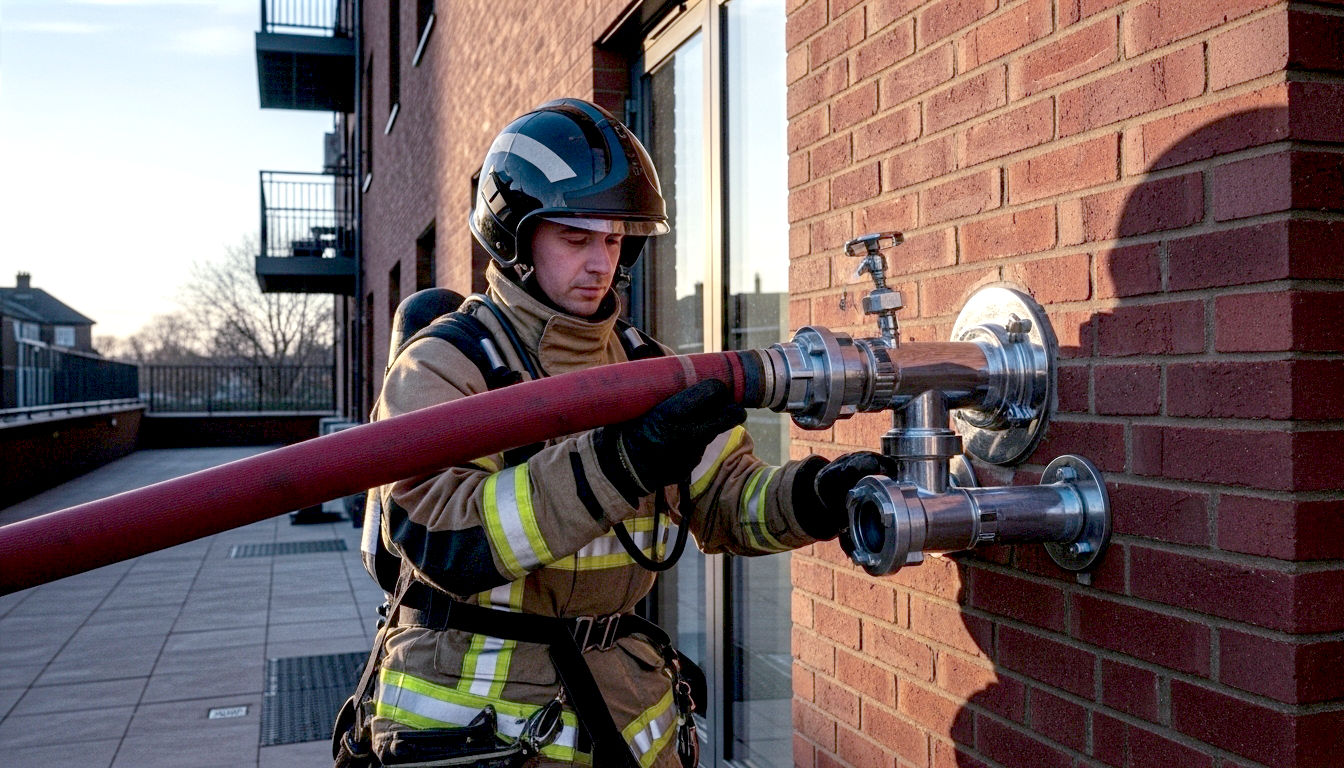The Unseen Guardian: Your Guide to Dry Risers in the UK
Discover everything about dry risers, the essential firefighting tool in tall buildings. Learn how they work, UK regulations, and who’s responsible.

This post may contain affiliate links. If you make a purchase through these links, we may earn a commission at no additional cost to you.
Picture this: a fire engine, blue lights flashing, screeches to a halt outside a tall block of flats in Manchester. Flames are licking out of a window on the eighth floor. Firefighters leap from the cab, but instead of starting the painstaking process of hauling heavy, water-filled hoses all the way up eight flights of stairs, one of them heads straight to a small, unassuming metal cabinet on the outside of the building. With a practised twist, they connect their thick hose to a set of shiny metal inlets.
Seconds later, their colleagues on the eighth floor connect their own hose to a valve on the wall, open it, and unleash a powerful jet of water directly onto the fire. The fire is tackled faster, the building is safer, and lives are more likely to be saved.
The quiet hero of this story is a piece of equipment you’ve probably walked past a thousand times without a second glance. It’s called a dry riser, and it’s one of the most important, yet least understood, parts of modern fire safety in the United Kingdom. It’s a silent guardian, hidden in the walls of our hospitals, shopping centres, and apartment blocks, waiting for the moment it’s needed most.
This guide will tell you everything you need to know about these vital systems. We’ll explore what they are, how they work, the laws that govern them, and why keeping them in perfect working order is a matter of life and death. Whether you’re a building owner, a tenant, or just a curious citizen, you’ll come away with a new appreciation for this brilliant, simple piece of engineering.
What Exactly is a Dry Riser? The Simple Answer
So, what is this thing we’re talking about?
In the simplest terms, a dry riser is like a built-in, empty water pipe that runs vertically up through a tall building. It has connections for the fire brigade on the outside at ground level and outlets, like taps, on every floor inside.
The key word here is ‘dry’. Most of the time, the pipe is completely empty. It’s not filled with water like your normal plumbing. It’s just a hollow tube, ready and waiting. When the fire brigade arrives, they hook their fire engine’s pump up to the bottom of the pipe and blast water into it at high pressure. This instantly fills the pipe, delivering a huge amount of water to every floor. Firefighters inside the building can then access this water immediately, right where they need it, saving precious time and energy.
Think of it like this: imagine trying to water a hanging basket on a second-floor balcony with a watering can. You’d have to keep running down to the garden tap, filling it up, and carefully carrying it upstairs. It would be slow and tiring. Now, imagine you had a permanent hosepipe running straight from the garden tap right up to the balcony. All you’d have to do is turn on the tap at the bottom, and the water would be there waiting for you.
A dry riser is that permanent hosepipe for firefighters. It’s a simple solution to a very dangerous problem: how to get a lot of water to the top of a tall building, very, very quickly.
Dry Risers vs. Wet Risers: What’s the Difference?
Now, you might have also heard of something called a ‘wet riser’. It sounds similar, and it does a similar job, but there’s one crucial difference.
- A Dry Riser is an empty pipe that the fire brigade fills with water when they arrive.
- A Wet Riser is a pipe that is permanently filled with pressurised water, ready to be used at a moment’s notice.
You might be wondering why we don’t just have wet risers everywhere. Well, it comes down to building height and maintenance.
Wet risers are typically required in much taller buildings—usually those over 50 metres (around 165 feet) high. This is because it would take a fire engine’s pump too long to push water all the way up a very tall skyscraper. For these giants, having water already in the system is essential for a rapid response. They have their own powerful pumps within the building to keep the water pressure high at all times.
Dry risers are used in buildings that are tall, but not that tall. In the UK, the rule of thumb is that any building with a floor more than 18 metres (about 60 feet) above the ground needs a riser. For buildings between 18 and 50 metres, a dry riser is usually the perfect fit.
The main advantage of a dry riser is simplicity. Because it’s empty, there’s no risk of the pipes freezing and bursting in a cold British winter. There’s also less chance of leaks, corrosion, or costly pump maintenance. It’s a beautifully low-tech and reliable system.
| Feature | Dry Riser | Wet Riser |
|---|---|---|
| Pipe Contents | Empty (filled by fire brigade) | Always full of pressurised water |
| Building Height (UK) | Typically 18m to 50m | Typically over 50m |
| Water Source | Fire engine pump | Building’s own pumps and tanks |
| Maintenance | Simpler, less risk of leaks/freezing | More complex, requires pump maintenance |
| Activation | Manual connection by firefighters | Instantly available |
A Quick Trip Back in Time: Where Did Dry Risers Come From?
The story of the dry riser is tied to the story of our cities. As towns like London, Liverpool, and Glasgow grew upwards in the late 19th and early 20th centuries, a new problem emerged. Buildings were getting taller than our ladders.
Before the invention of high-rise buildings, firefighting was a ground-level affair. You could point a hose at a three-storey house from the street. But when six, seven, or eight-storey office blocks and mansion flats started to appear, firefighters faced a huge challenge. The water pressure from hydrants on the street simply wasn’t strong enough to push water that high.
The only option was a ‘bucket brigade’ on a massive scale. Firefighters would have to physically drag incredibly heavy canvas hoses, filled with water, up flight after flight of stairs. It was exhausting, dangerous, and tragically slow. Fires on upper floors could get out of control long before the water ever reached them.
Engineers and visionary fire chiefs, like Captain Sir Eyre Massey Shaw of the London Metropolitan Fire Brigade, realised they needed to build the solution into the very fabric of the buildings themselves. The idea of a fixed, vertical firefighting pipe was born.
Early versions were simple, but the principle was the same. By installing a permanent empty pipe that firefighters could connect to at ground level, they turned the building itself into a piece of firefighting equipment. It was a revolutionary idea that has saved countless lives and has remained a cornerstone of fire safety engineering for over a century. The core design is so effective that it hasn’t changed all that much since those early days—a testament to its brilliant simplicity.
How a Dry Riser Works: A Step-by-Step Guide for Emergencies
To really understand a dry riser, let’s walk through what happens when it’s used in an actual emergency.
Step 1: Arrival and Connection The first fire engine arrives at the scene. While the crew commander assesses the situation, one of the firefighters immediately locates the inlet cabinet for the dry riser. This is usually a red (or sometimes grey or silver) metal box, often marked with the words ‘DRY RISER INLET’. It’s always on the outside of the building in a spot that’s easy for a fire engine to get to, typically within 18 metres of the vehicle.
Inside the cabinet is the inlet breeching—a metal fitting with two or more connections. The firefighter connects the thick hoses from the fire engine’s water pump to these inlets.
Step 2: Charging the System The pump operator on the fire engine gets the signal. They engage the pump, which starts forcing water from the engine’s tank (or a nearby hydrant) into the dry riser pipe at a very high pressure. This process is known as ‘charging the riser’.
Step 3: Air Vents Out, Water Rushes In As thousands of litres of water surge up the vertical pipe, the air that was inside needs to escape. At the very top of the riser system, there’s a small air release valve. This automatically lets the air out, allowing the pipe to fill completely with water in a matter of minutes. Without this valve, trapped air could cause dangerous pressure pockets or stop the system from filling properly.
Step 4: Connecting on the Fire Floor Meanwhile, the firefighting team has made its way up to the floor where the fire is (or, for safety, the floor below). On the wall of the stairwell or lobby of each floor, there is a landing valve. It looks a bit like a very heavy-duty tap, housed inside another metal cabinet.
The firefighters connect their attack hose to this landing valve. It’s the same standard connection they use on their fire engines, so everything fits perfectly.
Step 5: Water on the Fire With their hose connected and their breathing apparatus on, the team is ready to enter the flat or office. They open the landing valve, and the high-pressure water that has been pumped up from the engine below comes blasting out of their nozzle. They now have a continuous, powerful supply of water right where they need it most, without having to run a single hose up the stairs.
This whole process is slick, efficient, and dramatically cuts down the time it takes to start fighting the fire, which is the single most important factor in saving lives and property.
Getting to Know the Parts: The Anatomy of a Dry Riser System
A dry riser system is beautifully simple, made up of just a few key components. Understanding what they are and what they do helps to appreciate how the whole system works together.
The Inlet Breeching: The Connection Point
This is the gateway to the system. Found at ground level on the outside of the building, the inlet breeching is where the magic begins. It’s a sturdy metal fitting, usually made of bronze or stainless steel, that has two (and sometimes four) male connections for the fire brigade’s hoses.
The term ‘breeching’ comes from the idea of it looking like a pair of breeches or trousers, splitting one pipe into two connections. Having two inlets is a safety feature. It allows two hoses to be connected, ensuring a sufficient volume of water can be supplied. It also means that if one hose or connection has a problem, there’s a backup ready to go.
The inlet is housed in a locked cabinet to protect it from vandalism and dirt. The fire brigade carries a universal key that opens all riser cabinets in the UK, so they can never be locked out.
The Pipework: The Vertical Highway for Water
This is the backbone of the system. The pipe itself is made of heavy-duty galvanised steel, designed to withstand extremely high pressure without bursting. It’s usually about 100mm (4 inches) or 150mm (6 inches) in diameter—much wider than your household pipes—to allow a massive flow of water.
This pipe runs vertically through the building, usually hidden inside a service cupboard or a protected stairwell. It has to be securely fixed to the building’s structure to prevent it from moving or vibrating when it’s suddenly filled with thousands of litres of high-pressure water. The route of the pipe is carefully planned to be as straight as possible to help the water flow efficiently.
The Landing Valves: The Taps on Every Floor
If the inlet is the front door, the landing valves are the doors to each room. On every floor of the building, the vertical pipe has a T-junction with a special valve attached. This is the landing valve.
These are tough, globe-pattern screw-down valves, designed for reliability and ease of use in an emergency. They have a standard female outlet that perfectly matches the firefighters’ hoses. Like the inlet, each landing valve is kept inside a locked cabinet to protect it.
When a firefighter opens a landing valve, they are essentially ‘tapping into’ the pressurised column of water that is sitting in the vertical pipe, giving them instant access to the supply from the engine far below.
The Air Release Valve: Letting the Air Out
This small but clever component sits at the very highest point of the riser pipework. Its only job is to automatically let air escape as the pipe fills with water, and then seal itself shut once the water reaches the top.
Without it, charging the riser would be like trying to fill a bottle that has its cap on. The trapped air would compress, creating resistance and preventing the system from filling quickly and completely. This simple valve ensures the system is 100% full of water and ready for action.
The Rules and Regulations: Keeping Buildings Safe in the UK
You don’t just decide to put a dry riser in a building for fun. Their installation and maintenance are governed by strict laws and standards. This is to ensure that, no matter where a firefighter is in the country, every dry riser they encounter works in exactly the same, reliable way.
Why are Dry Risers Legally Required?
The requirement for dry risers is set out in law to protect life. The fundamental principle is that firefighters need to be able to work safely and effectively. In a tall building, that means having access to water without delay.
The main piece of legislation that covers fire safety in commercial and multi-occupancy residential buildings in England and Wales is the Regulatory Reform (Fire Safety) Order 2005. In Scotland, it’s the Fire (Scotland) Act 2005, and in Northern Ireland, it’s the Fire and Rescue Services (Northern Ireland) Order 2006.
These laws place the responsibility for fire safety squarely on the shoulders of the building’s owner, manager, or landlord. They are legally required to ensure the building is safe, which includes making sure that facilities provided for firefighters, like dry risers, are properly maintained and ready to use.
The All-Important British Standard: BS 9990:2015
This is the rulebook for dry risers in the UK. BS 9990:2015 is the British Standard that gives the detailed technical requirements for the design, installation, testing, and maintenance of dry and wet riser systems.
It’s an incredibly detailed document that covers everything, including:
- When a riser is needed: It confirms the 18-metre height rule.
- The materials to be used: Specifying the type and thickness of the steel pipes.
- The design of the inlets and outlets: Ensuring they are all a standard size.
- How the system should be installed: Including how it should be supported and where the cabinets should be placed.
- The testing procedures: Laying out exactly how the annual pressure test should be done.
Following this standard isn’t just good practice; it’s seen as the primary way to comply with the law. If there was a fire and the dry riser failed, one of the first questions an investigator would ask is: “Was the system maintained in accordance with BS 9990?”
Building Regulations: Approved Document B
When a new building is being constructed or an old one is being significantly altered, it must comply with the Building Regulations. The part that deals with fire safety is called Approved Document B.
This document states that any building with a floor more than 18 metres above the fire and rescue service access level must be equipped with a fire-fighting riser. It works hand-in-hand with BS 9990 to ensure that new buildings are designed with firefighter safety built in from day one.
Who’s in Charge Here? Responsibility for Dry Riser Maintenance
This is one of the most important questions, and the answer is crystal clear: the ‘Responsible Person’ for the building.
Under the Fire Safety Order, every building (other than a private house) must have a designated ‘Responsible Person’. This is usually:
- The owner of the building.
- The landlord.
- A managing agent or facilities manager appointed by the owner.
- In the case of a block of flats, it could be the freeholder or a residents’ management company.
This person has a legal duty to take reasonable steps to reduce the risk from fire and make sure people can safely escape if a fire does start. A huge part of that duty is ensuring that any firefighting facilities are in good working order.
What the Law Says You Must Do
The law requires the Responsible Person to ensure the dry riser system is:
- Visually inspected every six months.
- Subjected to a full wet pressure test every year.
Failing to do this is a criminal offence. The consequences can be severe, including unlimited fines and even prison sentences in the most serious cases. More importantly, a poorly maintained riser could fail during a fire, leading to a delayed response that could cost lives. Ignorance is no excuse; if you are responsible for a building, you are responsible for its dry riser.
Keeping It in Top Nick: Testing and Maintenance Explained
A dry riser is a simple system, but it’s not immune to problems. Vandalism, dirt, neglect, and wear and tear can all stop it from working when it’s needed most. That’s why a strict testing regime is so essential.
The Weekly Check-up: A Visual Inspection
While the standard requires a six-monthly check, good practice (and many fire risk assessors) recommend a more frequent, informal look-over. This is a simple visual inspection that anyone can do. It involves checking that:
- All inlet and landing valve cabinets are closed and undamaged.
- The glass panels on the cabinets are intact.
- There are no obvious signs of leaks or corrosion around the valves.
- The valves and their handwheels haven’t been vandalised or stolen (the brass and gunmetal parts are attractive to metal thieves).
- Access to the inlet cabinet is not blocked by rubbish bins, parked cars, or overgrown plants.
Any problems should be reported and fixed immediately.
The Big One: The Annual Pressure Test
This is the full MOT for the dry riser and must be carried out by a specialist company. The test, as laid out in BS 9990, involves filling the entire system with water and using a special pump to pressurise it to 12 bar (about 175 psi) for at least 15 minutes.
This is a much higher pressure than it would normally be used at, and it’s a brilliant way to find any hidden problems. During the test, the engineers will check every single valve and joint for even the tiniest leak.
After the test, they will issue a certificate to prove the system has passed. This certificate should be kept as part of the building’s fire safety records. The system is then fully drained, leaving it empty and ready for another year.
Common Problems to Watch Out For
Dry riser engineers see the same problems time and time again. The most common culprits are:
- Vandalism and Theft: Inlet and landing valves are often stolen for their scrap metal value. This renders the entire system useless.
- Seized Valves: If the valves aren’t regularly moved, they can become stiff and impossible to open in an emergency.
- Blockages: Rubbish, debris, and even birds’ nests can find their way into open outlets, creating blockages that would stop the water flow.
- Leaking Gaskets and Seals: The rubber seals inside the valves perish over time and need to be replaced. The annual wet test is excellent at finding these slow leaks.
Regular maintenance is the only way to catch these problems before they can turn a crisis into a catastrophe.
Dry Risers in Action: Lessons from Real-Life Events
The crucial role of dry risers has been highlighted in reports from major incidents. In the aftermath of the tragic fire at Grenfell Tower in 2017, the public inquiry looked at every aspect of the building’s fire safety. The report noted that the dry riser in the building did not work as it should have, which “severely hampered” the firefighters’ ability to get water to the upper floors and “increased the risks to them”.
This devastating event, and others like it, serve as a stark reminder that these systems are not just a box-ticking exercise. They are a vital tool for firefighters. When they work, they save lives. When they fail, the consequences can be horrific.
The Grenfell tragedy led to sweeping reviews of building safety in the UK, and the proper maintenance and testing of essential systems like dry risers has come under renewed and intense scrutiny. It reinforced the message that the duties of the ‘Responsible Person’ are not just administrative—they are a core part of protecting the people who live and work in our high-rise buildings.
The Future of Firefighting in High-Rise Buildings
While the dry riser remains a brilliantly effective and simple tool, technology doesn’t stand still. The fire safety world is constantly looking at ways to make fighting fires in complex buildings even safer and more efficient.
We are seeing advancements in pump technology, more resilient materials, and the integration of ‘smart’ systems that can monitor the pressure and integrity of a riser system in real time, alerting the building manager to a problem the moment it happens.
For very tall and complex new buildings, architects and engineers are designing ever more sophisticated systems, sometimes with multiple wet and dry risers serving different zones of the building. However, for the tens of thousands of existing buildings across Britain, the classic dry riser, properly maintained and regularly tested, will remain the workhorse of high-rise firefighting for many decades to come.
Conclusion: The Silent Guardian in the Walls
The humble dry riser is a perfect example of great engineering: it’s simple, robust, and does its job incredibly well. It has no moving parts to go wrong, no complex electronics to fail. It is just a pipe. But it’s a pipe that can make the difference between a controllable incident and an uncontrollable disaster.
The next time you’re walking through a city centre or entering an apartment block, take a moment to look for that little red cabinet. Now you know what it is, you’ll start seeing them everywhere. See it not as a simple piece of plumbing, but as a lifeline for the brave men and women of the Fire and Rescue Service, and a silent promise of safety for everyone inside. It is a true unseen guardian, standing ready in the walls.
Further Reading
For those who wish to delve deeper into the technical standards and regulations, here are some highly respected resources:
- The Fire Protection Association (FPA): The UK’s national fire safety organisation, providing a wealth of information and training. https://www.thefpa.co.uk/
- British Standards Institution (BSI): The place to find and purchase the official BS 9990:2015 standard. https://www.bsigroup.com/
- UK Government Fire Safety Guidance: Official guidance on the Regulatory Reform (Fire Safety) Order 2005. https://www.gov.uk/workplace-fire-safety-your-responsibilities






